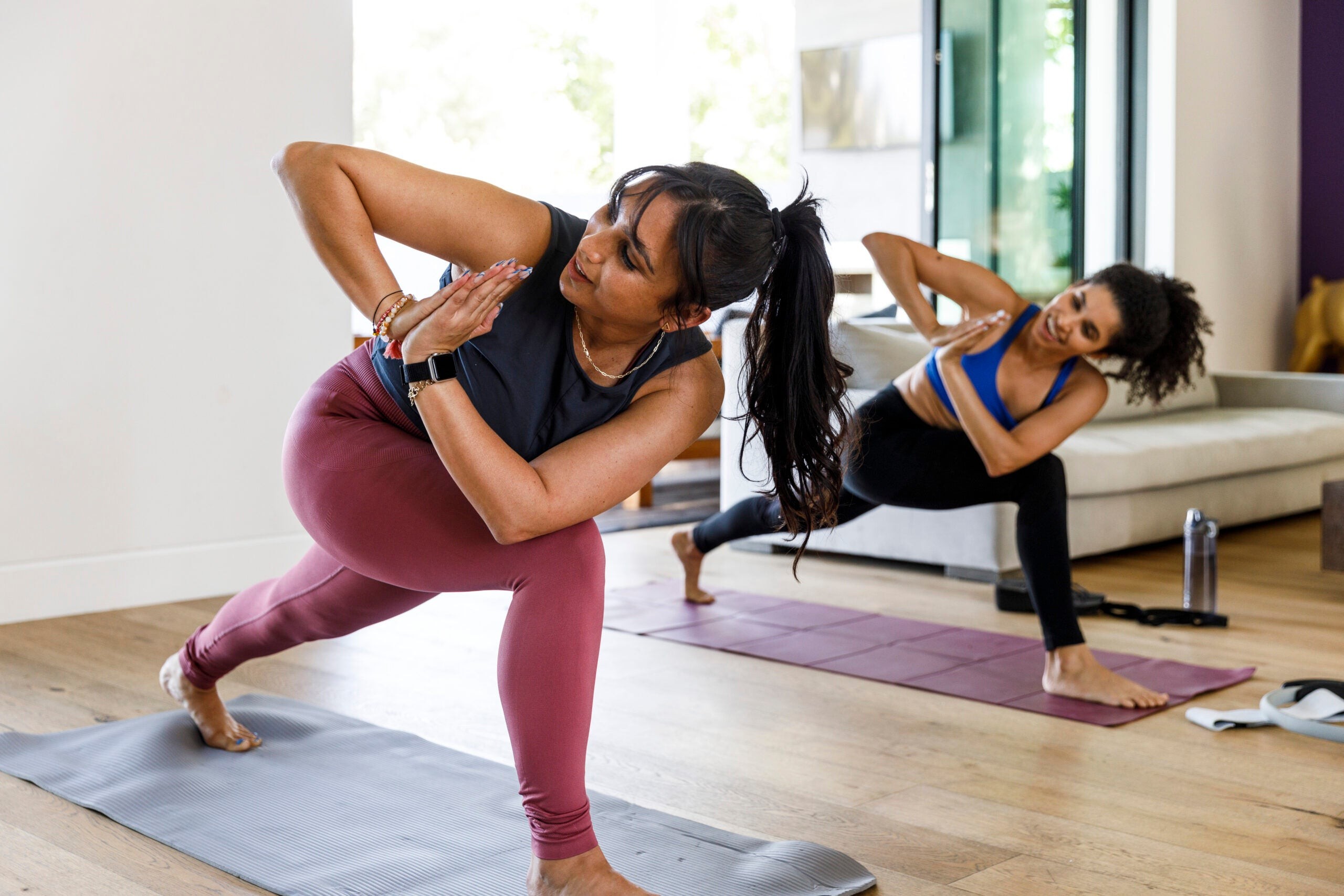Yoga, often perceived as an exclusive practice reserved for the flexible and experienced, is actually accessible to everyone. Forget the gravity-defying Instagram poses; yoga is about improving flexibility and well-being, both physically and mentally. This guide provides all the essential information for beginners, covering the benefits of regular practice, beginner-friendly poses, how to find the right class, practicing at home, and more.
Understanding Yoga
The word “yoga” originates from a Sanskrit term meaning “to yoke” or “to unite,” reflecting the practice’s aim to harmonize the mind, body, and spirit.
While modern Western yoga often emphasizes asana, the physical practice, these postures are only one component of yoga. Ancient philosophical texts define yoga as a state of mind, independent of physical movements.
Indu Arora, an Ayurveda and yoga therapist, explains that yoga’s roots are in the Vedas, ancient Indian texts dating back 3,000 to 5,000 years. Yoga, according to Arora, is “that harmonious, peaceful, content, still state of mind.”
Focusing on breath, or pranayama, is essential. “Prana” signifies life force, while “ayama” means to extend or draw out, hence breath control. Some teachers consider pranayama the most vital aspect of yoga.
Health Benefits of Yoga
Regular yoga practice offers a wide range of health benefits, positively impacting physical, mental, and emotional well-being.
Flexibility and Strength
Yoga’s movements, stretches, and deep breathing enhance blood flow, stretching and strengthening muscles. This improves overall physical fitness.
Pain Relief
Research indicates yoga can alleviate chronic and acute pain, particularly low back pain. Regular practice can provide significant relief.
Reduced Inflammation
Stress and inactivity can cause chronic inflammation, increasing disease risk. Yoga can counteract this by lowering levels of the inflammation-promoting immune cell IL-6 and cortisol, the “stress hormone.”
Better Heart Health
Extensive evidence supports yoga’s effectiveness in improving heart health, managing heart conditions, and reducing cardiovascular disease risk.
Decreased Symptoms of Depression, Anxiety, and Stress
Yoga reduces depressive symptoms, stress, and anxiety. Meditation, a key component, is also effective in relieving depression symptoms.
Improved Focus
Holding poses, intentional breathing, and meditation enhance attention by syncing breath with movement and letting go of distracting thoughts.
Increased Gratitude
Studies show regular yoga promotes positive emotions and body image. Kiesha Battles, a yoga teacher, notes that yoga provides clarity for dealing with life’s challenges.
Better Sleep
Consistent yoga practice can reduce the time it takes to fall asleep, decrease sleep disturbances, and improve overall sleep quality.
Types of Yoga
Yoga class schedules often include various types of yoga that differ in intensity, focus, and style. Some common styles include:
- Hatha: A general term for physical yoga practices.
- Vinyasa: A dynamic, flowing style that synchronizes breath with movement.
- Ashtanga: A rigorous, sequential series of poses.
- Bikram: Yoga performed in a heated room.
- Restorative: Gentle, supported poses for relaxation.
- Yin: Long-held poses targeting deep connective tissues.
Best Yoga Poses for Beginners
Here are six fundamental yoga poses suitable for beginners, each with modifications to accommodate different body types:
Mountain Pose (Tadasana)
Mountain Pose engages leg and core muscles while improving body awareness and alignment.
How to:
- Stand with big toes touching, heels slightly apart.
- Reach tailbone toward the floor.
- Broaden collarbones, arms at sides, palms forward.
- Hold for up to 10 breaths.
Cat Pose (Marjaryasana)
Cat Pose relieves tension in the back and improves posture. It’s often paired with Cow Pose.
How to:
- Start on hands and knees, knees below hips, wrists below shoulders.
- Exhale, round spine toward ceiling, release head without forcing chin to chest.
- Repeat 5 to 10 times.
Cow Pose (Bitilasana)
Cow Pose increases mobility, especially for those with muscle and joint stiffness, and can be done in a chair.
How to:
- Start on hands and knees, knees below hips, wrists below shoulders.
- Inhale, lift sitting bones and chest toward ceiling, belly toward floor. Lift head to look forward.
- Exhale, return to hands and knees.
- Repeat 5 to 10 times.
Cobra Pose (Bhujangasana)
Cobra Pose may improve symptoms of chronic low back pain by enhancing flexibility and core strength.
How to:
- Lie on stomach, palms on floor, fingertips in line with mid-chest. Use a towel or blanket under hip bones for cushion.
- Press palms into floor, draw shoulder blades together, keep shoulders down.
- Keep a bend in arms, expand chest forward.
- Hold for 5 to 10 breaths, lower to floor.
Child’s Pose (Balasana)
Child’s Pose stretches the lower back and hips. It’s often used as a resting pose.
How to:
- Begin seated, bottom on feet (use a blanket for comfort).
- Touch big toes together, widen knees, walk hands forward.
- Bring forehead to floor (use a book or blanket for support).
- Stay for 30 seconds to a few minutes, then walk hands back to seated.
Corpse Pose (Savasana)
Savasana offers inner stillness and deep relaxation after physical movement, reducing stress.
How to:
- Lie on back, soften lower back (use a blanket for support).
- Release arms to floor, palms up, shoulder blades evenly resting.
- Soften tongue, relax face.
- Stay for at least 5 minutes, roll to one side, take 2-3 breaths, then lift torso slowly.
Breathwork for Beginners
Breathwork, or pranayama, includes techniques like slowing the breath and Ujjayi breathing, which involves equal length inhalations and exhalations created by constricting the throat.
In a study, pranayama was linked to stress relief, improved cardiovascular health and respiratory function, and enhanced cognition.
Remember: “Movement with awareness is yoga. Movement without awareness is exercise.”
Philosophy of Yoga
The Yoga Sutras of Patanjali outline how to achieve a yogic state of mind through eight limbs:
- Yamas (Restraints): Ethical guidelines like non-violence and truthfulness.
- Niyamas (Observances): Self-discipline and inner practices like cleanliness and contentment.
- Asana (Posture): Physical postures for health and mindfulness.
- Pranayama (Breath Control): Techniques to control and extend breath.
- Pratyahara (Withdrawal of the Senses): Turning inward and detaching from external stimuli.
- Dharana (Concentration): Focusing the mind on a single point.
- Dhyana (Meditation): Sustained focus leading to a state of deep contemplation.
- Samadhi (Liberation): A state of union and enlightenment.
How to Find a Beginner Yoga Class
To find a class, search online for “Beginner yoga classes near me.” Many studios have online schedules or use apps for booking. Classes described as foundational, gentle, restorative, or yin are excellent starting points. Contact studios to inquire about beginner-friendly classes and discuss any injuries or health conditions.
Free Beginner Yoga Classes
Numerous free online resources are available for practicing yoga at home.
What to Wear
Wear stretchy, comfortable clothing like yoga pants, gym shorts, sweatpants, or a sweat-wicking top.
What to Bring
Bring a water bottle. Studios often rent yoga mats and provide sanitizing wipes. As you progress, consider purchasing your own mat and props.
Props and Equipment
Props make yoga more accessible and comfortable. Common props include blocks, blankets, straps, and bolsters.
Basic Yoga Class Etiquette
Yoga is a mind-body-spirit practice. Be open to breathwork, meditation, and intention-setting. Remove shoes before entering the practice space as a sign of respect. While teachers may offer adjustments, you can decline. Always voice any discomfort.
Common Yoga Terms
Yoga teachers often use Sanskrit names for poses. Understanding some common terms is helpful:
- Asana: Posture
- Pranayama: Breath control
- Namaste: A greeting meaning “I bow to you.”
- Ujjayi: A specific breathing technique.
- Shanti: Peace
By embracing these guidelines, beginners can embark on a fulfilling yoga journey, enhancing their connection to their body, mind, and soul.

